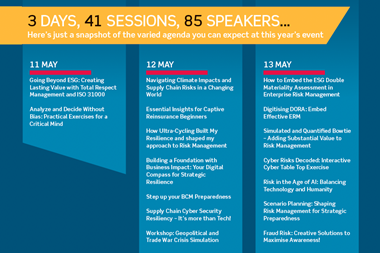Globalisation, making strategic alliances, corporate governance imperatives, increasingly competitive markets, political unrest and terrorism - uncertainty and risk are everywhere. Risk and its management have always been implicit in marketing activities. Now that events have catapulted risk into the forefront of business thinking, it is likely that marketing directors will increasingly be required to show how marketing activity is risk assessed.
Even if marketing departments themselves do not overtly embrace risk management, it will influence marketing through other organisational initiatives, such as enterprise-wide risk management. Such initiatives will be led by other functions, such as finance or audit, which could leave marketing without direct influence on the board.
Marketing business risks include:
The project risk and operational risk dimension is just as important as the more general business risk. Once marketing people make a decision on strategy, they must take some responsibility for convincing the board, not just that it is a good idea, but that it will happen - in other words, that the project and operational risks are covered.
This involves more than setting a realistic budget, compiling an impressive GANTT chart, or ensuring the right type and number of staff. A whole raft of operational risks, from potential IT failure to supply chain vulnerabilities, needs to be understood and managed. If the supply chain fails, it is no good blaming suppliers when confronted by an angry customer. We choose the suppliers and own the process of supply.
Most marketing plans and initiatives involve change, and change is extremely risky. Robust project risk assessment is appropriate and necessary. All may go well with marketing's plans but how will situations be dealt with when things do not work out? Often in debriefs on failed products or initiatives we hear 'Nobody thought of ...'. While truly random events do sometimes occur, it is evident that in many instances it is possible to isolate a set of project-damaging risks, which should be addressed. This will require the establishment of a mitigation, treatment or quick response approach.
Now is a good time to check just how well marketing is managing risk. Evidence from research suggests that most senior business managers recognise the importance of risk, but tend to manage it by instinct rather than through a robust set of tools and techniques. There are a number of reasons for this. They include a rational lack of confidence in the tools and techniques at our disposal, and an emotional objection to highlighting risk as being negative, or as giving decision makers excuses to cancel important marketing initiatives.
We regularly hear that marketing needs to demonstrate its effectiveness in hard quantifiable figures, explaining how it adds value to the business in terms of creating value for the customers, delivering longer term shareholder value and in meeting the needs of all stakeholders. However, even after all the facts are gathered and assumptions challenged, the residual uncertainty in marketing activities is often significant. So it is logical that sound measures of marketing effectiveness must include a risk assessment if they are to be convincing?
It is difficult to identify any widely-used marketing textbook which understands and outlines the importance of risk management to the development and implementation of marketing strategy and planning. Risk and uncertainty are rarely to be found in indexes to such books, although one of its outcomes, contingency planning, will often get a cursory mention.
This is not to say that risk-assessed marketing cannot be found in industry and commerce, but it is not always explicit, nor the norm. Many agricultural markets, where price and product availability risks can be high, are excellent at risk-assessed marketing . It appears, though, that this is the exception rather than the rule.
Techniques
Marketing planning as a process (whether linear or emergent) is hospitable to risk management. A number of tools and techniques which are often used in marketing planning are clearly part of a sound approach to risk management. The most obvious tool is market research, but other tools and techniques also help to understand and manage risk. The Ansoff matrix, for instance, helps analyse and evaluate the risk in a portfolio of marketing strategy options. A rigorous SWOT analysis, which goes beyond simply brainstorming to a more reflective judgement on the likelihood, consequences and timescales of the factors identified, is also a sound risk management tool. Scenario analysis is increasingly being employed to identify what a company needs to do to ensure that, no matter what, it survives the uncertainty all around. Project risk tools such as fault tree analysis (FTA) abound and are occasionally seen in marketing planning exercises.
What is missing is a rigorous explicit risk management process, supported by a marketing-specific set of tools and techniques, implemented by marketing departments as part of the way they do their initial planning. Project management, for instance, will often kick in after a marketing plan has been delivered, rather than being an essential part of its creation. The attitude seems to be: 'Here's a few good ideas we've chosen, now go away and project manage them'. This leads to inevitable conflicts of time and resources. Project management risk should be embedded in the creation of marketing plans at the point of decision making between competing strategy options, rather than simply being seen as a process that kicks in when decisions have been taken and their outcomes offered for implementation.
Traditional formal risk management will tend to have the elements illustrated in Figure 1.
An explicit risk management approach in strategic marketing planning will include a formal risk management cycle at two critical points:
Marketing people show how they affect volume, value and market share, but now is the time for them to show how they reduce the risks to shareholder value and enhance opportunities. Otherwise they are only giving the board half the story.
Who knows? The board may even embrace risk assessed marketing as a real compliance outcome for Turnbull and Higgs, which together see an important risk management role for executive and non-executive directors.
Terry Kendrick is director of Information Now Ltd, Tel 01603 628 818, E-mail terry.kendrick@btconnect.com



















